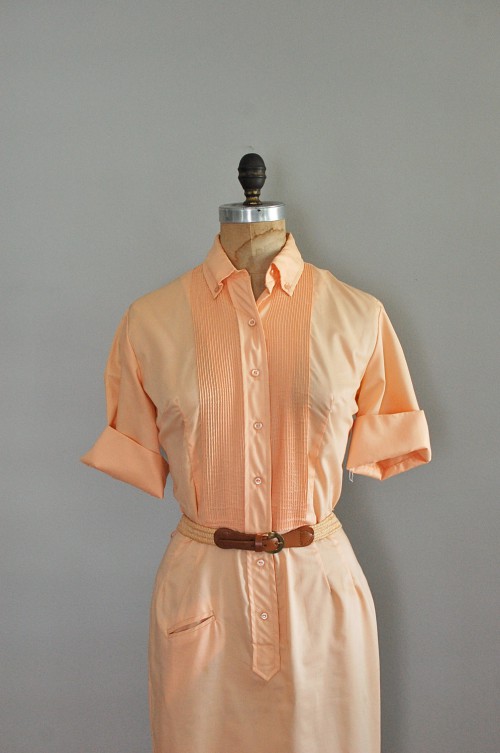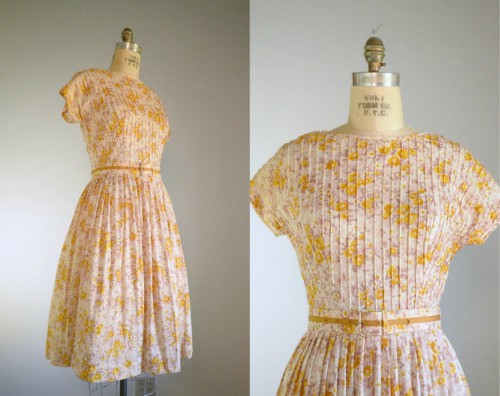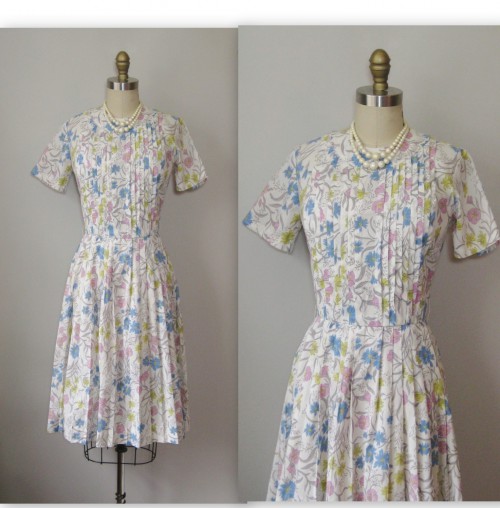Detail Inspiration: Tucks
A tuck is a fold that’s been stitched in place. A very thin fold is referred to as a pintuck. Pintucks are a versatile detail you can add to the simplest of garment designs.
You can have as many or as few tucks as you like and add them anywhere on the garment that doesn’t interfere with darts. They can go in just about any direction you like. In fact you could make an entire garment of tucks! It might be tedious sewing up all those tucks, though. Many sewing machines have pintuck feet to make sewing them easier. Have you had experience sewing tucks? Do you have any tricks you use? What are some ideas these images give you for future projects? I think they’d look great on a shirt or a dress bodice in a solid color so you can really see the detail.

 Sign In
Sign In






Comments
Gail Ann Thompson
July 15, 2011 #
I love, love, love that Yellow, pin tuck number!!!!
Also, yesterday, when I took your survey I couldn’t remember the name of the “Money is NO Object” place where I’d like to buy my clothes, it’s called Puttin on the Ritz. So please add that to your list.
Sarai
July 15, 2011 #
Thanks Gail, I got your email about that as well. I will add it to my survey. :)
Melanie
July 15, 2011 #
I see pin ticks On the white yoke of a baby dress I’m contemplating for baby girls first birthday.
Sarai
July 15, 2011 #
Oh yes, they look lovely on baby and children’s clothes, especially in an heirloom fabric like batiste.
Reader
July 15, 2011 #
There are many different types of tucks: Spaced tucks, blind tucks, pintucks, etc. Colette Wolf’s “The Art of Manipulating Fabric” provides many examples.
Sarai
July 15, 2011 #
This is one of my favorite sewing books, actually. Lots of great techniques in there.
Tasha
July 15, 2011 #
Love the look of them! I did a blouse once that had horizontal tucks across the chest that were really neat. And not too many of them to make you crazy doing them, either. Sadly the blouse has since been given away since the fit wasn’t great (it was one of my first projects last year), but I hope to revisit the pattern at some point and am inspired again by this post!
I admit I’ve been a bit confused at the use of the term ‘dart tuck’ in some sewing patterns, however.
Sarai
July 15, 2011 #
I don’t see the term “dart tuck” used all that frequently, but I believe it’s a tuck that is specifically used like a dart, to control fullness in an area.
According to Harriet Pepin, “As a substitute for the simple shortened dart, in some instances, the dart-tuck is used. It is so named because it tapers like a dart but ends abruptly, like a tuck, or pleat.”
So, for example, the waistlin tucks on the Sencha blouse could be considered “dart tucks.”
Tasha
July 18, 2011 #
Ah, thanks! That makes a lot of sense. I believe I’d seen the term used in older sewing books or patterns, so that would explain me not being able to find much info now or seeing the term used much.
Lizz
July 15, 2011 #
I love tucks! In fact, I’ve added two different types to my Sorbettos. My favorite way to make a pintuck is corded with a twin needle. They look so great and really pop!
Sarai
July 15, 2011 #
Absolutely! Here’s a tutorial Rachel did on corded pintucks using a twin needle, for anyone else that wants to give it a shot.
Lena
July 15, 2011 #
I have yet to make anything with lots of tucks, but I love the look of them. I hope to try my hand at them in the future!
p.s. The yellow dress is my favorite!
Shelly
July 15, 2011 #
I love the look of pintucks although I have not yet used them on anything. I think they are a great design feature especially on plain fabrics. I hope to use them next Summer on a blouse.
BTW the yellow blouse? at the top is gorgeous!
Marina v.K. (Frabjous)
July 16, 2011 #
If pin tuck ends do not start or end in a seem and are exposed, I sew them using one-thread technique, in which I wind up the bobbin thread up on the spool – enough to sew one dart – and then stitch from the exposed end. I had a tutorial on my blog for a one-thread dart – pin tucks would work the same way. (http://frabjous-fashion.blogspot.com/2011/04/couture-technique-one-thread-dart.html).
Another option is to pull the threads to the wrong side and knot them, this way you won’t need to backstitch and there will be no unsightly thread ends.
But for sheer fabrics, the first method is the best in my opinion.
Caitlin
July 18, 2011 #
What a great tip! I’ve read about this before but haven’t tried it. I’ll have to give it a go next time I’m working with that type of tuck.
Debbie
July 17, 2011 #
I truly enjoy these posts. One of the things that I want to try out is my tucking/tucker attachment for my sewing machine. Pintucks are so neat for adding interest and special details to an item of clothing.
When I saw the Sorbetto pattern (a style that I totally love), my first thought was to give my tucker attachment a go as an experiment.
Thank you all so much for the thoughtfulness that goes into each of these posts, for my part, the information and tutorials you all share is very much appreciated.
Debbie…(O:
>
Caitlin
July 18, 2011 #
Thank you for the kind words, Debbie! I’m so glad that you enjoy these posts. :)
Tasha
August 19, 2011 #
p.s. this is funny, I came back to this post to do a bit more reading for inspiration on pintucks, and lo and behold– I bought that top yellow blouse recently on Etsy and I am, in fact, wearing it right now! I didn’t even remember that I’d seen it here, but apparently I was inspired enough by pintucks the first ’round to go buy a shirt with them. :)